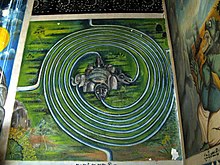
The Euphrates is the longest and one of the most historically important rivers of Western Asia. Together with the Tigris, it is one of the two defining rivers of Mesopotamia. Originating in Turkey, the Euphrates flows through Syria and Iraq to join the Tigris in the Shatt al-Arab in Iraq, which empties into the Persian Gulf.

In Abrahamic religions, the Garden of Eden or Garden of God, also called the Terrestrial Paradise, is the biblical paradise described in Genesis 2–3 and Ezekiel 28 and 31.

The geography of Iraq is diverse and falls into five main regions: the desert, Upper Mesopotamia, the northern highlands of Iraq, Lower Mesopotamia, and the alluvial plain extending from around Tikrit to the Persian Gulf.
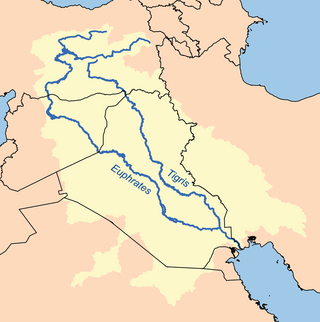
The Tigris is the eastern of the two great rivers that define Mesopotamia, the other being the Euphrates. The river flows south from the mountains of the Taurus in Turkey, then through the Syrian and Arabian Deserts, emptying into the Persian Gulf.

Mount Meru, also known as Sumeru, Sineru, or Mahāmeru, is the sacred five-peaked mountain of Hindu, Jain, and Buddhist cosmology and is considered to be the centre of all the physical, metaphysical, and spiritual universes. The mountain is also mentioned in some scriptures of non-Indian based religions such as Taoism, which was influenced by the arrival of Buddhism in China. There is no clear identification of Mount Meru with a particular geophysical location but it is always located in Himalayan or Aravali ranges.

Biblical cosmology is the account of the universe and its laws in the Bible. The Bible was formed over many centuries, involving many authors, and reflects shifting patterns of religious belief; consequently, its cosmology is not always consistent. Nor do the biblical texts necessarily represent the beliefs of all Jews or Christians at the time they were put into writing: the majority of the texts making up the Hebrew Bible or Old Testament in particular represent the beliefs of only a small segment of the ancient Israelite community, the members of a late Judean religious tradition centered in Jerusalem and devoted to the exclusive worship of Yahweh.
The paradise garden is a form of garden of Old Iranian origin, specifically Achaemenid which is formal, symmetrical and most often, enclosed. The most traditional form is a rectangular garden split into four quarters with a pond in the center, a four-fold design called chahar bagh. One of the most important elements of paradise gardens is water, with ponds, canals, rills, and fountains all being common features. Scent is an essential element with fruit-bearing trees and flowers selected for their fragrance.
Gihon is the name of the second river mentioned in the second chapter of the biblical Book of Genesis. The Gihon is mentioned as one of four rivers issuing out of the Garden of Eden that branched from a single river within the garden.

The Pishon is one of four rivers mentioned in the Biblical Book of Genesis. In that passage, a source river flows out of Eden to water the Garden of Eden and from there divides into the four named rivers. The Pishon is described as encircling "the entire land of Havilah where is gold; bdellium and onyx stone."
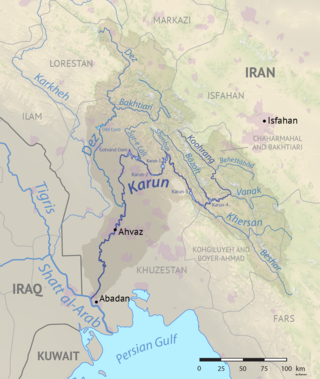
The Karun is the Iranian river with the highest water flow, and the country's only navigable river. It is 950 km (590 mi) long. The Karun rises in the Zard Kuh mountains of the Bakhtiari district in the Zagros Range, receiving many tributaries, such as the Dez and the Kuhrang. It passes through the capital of the Khuzestan Province of Iran, the city of Ahvaz, before emptying to its mouth into Arvand Rud.

Jambudvīpa is a name often used to describe the territory of Greater India in ancient Indian sources.

The Karkheh or Karkhen is a river in Khūzestān Province, in southwest Iran.
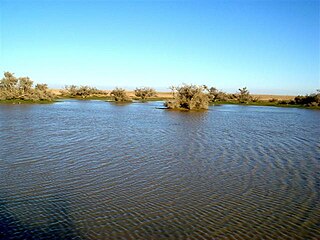
Wadi al-Batin is an intermittent river in Saudi Arabia, Iraq, and Kuwait. It is the lowest and final section of Wadi al-Rummah. It runs 45 mi (72 km) in a northeast–southwest direction through the Al-Dibdibah plain and has been recognized since 1913 as the border between Kuwait and Iraq.

Juris Zarins (Zariņš) was a German-born American archaeologist and professor at Missouri State University, who specialized in the Middle East.
Jōn al Kuwayt, also known as Kuwait Bay, is a bay in Kuwait. It is the head of the Persian Gulf. Kuwait City lies on a tip of the bay.
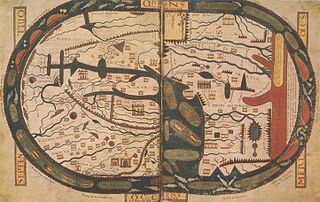
The Beatus Map or Beatine Map is one of the most significant cartographic works of the European Early Middle Ages: It was originally drawn by the Spanish monk Beatus of Liébana, based on the accounts given by Isidore of Seville, Ptolemy and the Hebrew Bible. Although the original manuscript is lost, there remain several copies extant, which retain a high fidelity with respect to the original.
Dvipa is a term in Hindu cosmography. The Puranas describe a dvipa to be one of the seven islands or continents that are present on earth, each of them surrounded by an ocean. The same terminology is also used to refer to the seven regions of the cosmos.
Four rivers may refer to:

The concept of a garden of the gods or a divine paradise may have originated in Sumer. The concept of this home of the immortals was later handed down to the Babylonians, who conquered Sumer.
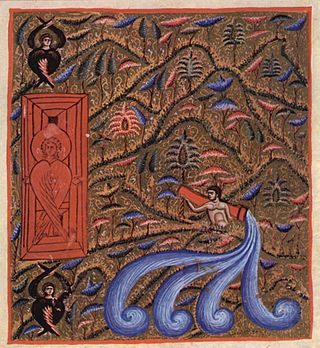
Rivers of Paradise, the four rivers of Paradise, or "the rivers of/flowing from Eden" are the four rivers described in Genesis 2:10–14, where an unnamed stream flowing out of the Garden of Eden splits into four branches: Pishon, Gihon, Hiddekel (Tigris), and Phrath (Euphrates). These four rivers form a feature of the Garden that is popular in the Abrahamic religions.

